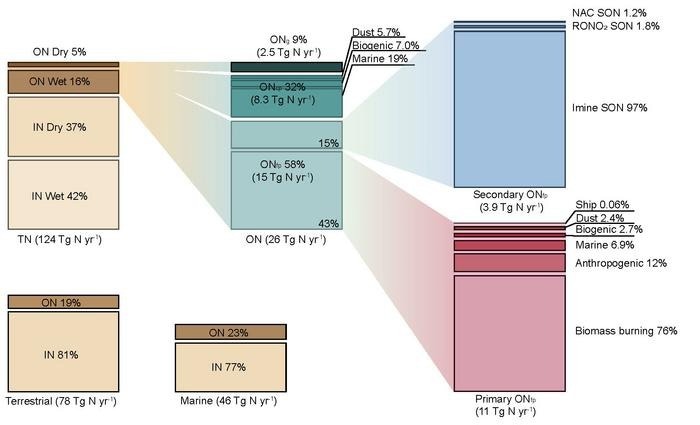Recent research underscores the previously underestimated importance of atmospheric organic nitrogen (ON) aerosol depositions on ecosystems. Moreover, it is expected that the ecological effects of ON aerosol depositions are anticipated to intensify due to global warming and the reduction in nitrogen oxide emissions from human activities.
 The global atmospheric total nitrogen (TN) deposition flux and the contributions of different N components as simulated by this study. Image Credit: Science China Press
The global atmospheric total nitrogen (TN) deposition flux and the contributions of different N components as simulated by this study. Image Credit: Science China Press
The study, led by Dr. Yumin Li from the Southern University of Science and Technology (SUSTech), was a collaborative effort involving Professor Tzung-May Fu's team at SUSTech and Professor Jian Zhen Yu's team at the Hong Kong University of Science and Technology (HKUST).
Atmospheric deposition of organic nitrogen (ON) is an integral component of the global nitrogen cycle. Surface measurements have indicated that, in local areas, organic nitrogen constitutes between 2% and 70% of the total atmospheric deposition flux of nitrogen. Nonetheless, previous models have largely overlooked the spatial and chemical variations in atmospheric ON, resulting in an insufficient evaluation of its worldwide consequences.
Researchers from SUSTech and HKUST formulated an extensive global model encompassing atmospheric gaseous and particulate organic nitrogen (ON), drawing on the most recent insights regarding emissions and secondary formation processes.
Their model effectively generated simulated surface concentrations of atmospheric particulate ON (ONp), showcasing significant concordance with global observations, a noteworthy achievement previously unattained. Furthermore, their simulations of atmospheric deposition flux were within the same order of magnitude as global observations.
The researchers' estimation indicated that the worldwide deposition of atmospheric organic nitrogen (ON) amounted to 26 teragrams (Tg) of nitrogen per year. A significant portion of this deposition, roughly 23 Tg N yr-1, took the form of ON aerosols, constituting 19% of the total global atmospheric nitrogen deposition, which stands at 124 Tg N yr-1. The primary contributors to ON aerosols were wildfires, emissions from the ocean, and secondary formation processes.
Our simulation showed that the deposition of ON aerosol from the atmosphere is a crucial external source of nitrogen to nitrogen-limited ecosystems worldwide, such as the boreal forests, tundras, and the Arctic Ocean.
Tzung-May Fu, Professor, Southern University of Science and Technology
In a future marked by global warming, wildfires are anticipated to become more frequent and intense. Additionally, climate warming will result in surface ocean stratification. These changes emphasize the growing significance of atmospheric organic nitrogen (ON) deposition as a vital source of nitrogen for these ecosystems.
We need to further examine the environmental impacts of atmospheric ON aerosol and how those impacts respond to climate change.
Tzung-May Fu, Professor, Southern University of Science and Technology
Journal Reference:
Li, Y., et al. (2023). Dissecting the contributions of organic nitrogen aerosols to global atmospheric nitrogen deposition and implications for ecosystems. National Science Review. doi.org/10.1093/nsr/nwad244.